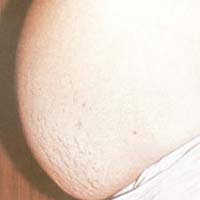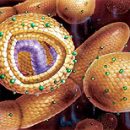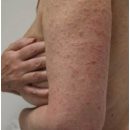In most cases, changes occurring in liver under cirrhosis do not undergo inverse changes. The main task of treatment is aimed at slowing the processes of progression of the disease and eliminate complications of such complications as ascites.
Content
Treatment of liver and ascite cirrhosis
An important aspect of the treatment of a patient suffering from cirrhosis of the liver, which is accompanied by ascites, is its mode of life and nutrition.
 Here are just some general advice that can positively affect the quality of the patient's life. The best means of eliminating fatigue feelings is rest, especially sleep. Due to the threat, the development of bleeding from varicose veins (hemorrhoids, esophageal) should not be lifted. Monitoring the intestinal emptying frequency - the most optimal to do twice a day, with the trend towards the constation, the number of plant fibers (wheat bran), honey, with ineffectiveness, should increase in the food diet - Add Lactulose. This drug is a synthetic carbohydrate that is not digested and not absorbed in the intestine. Due to this lactulose has a relaxing effect. In addition, a regular chair in a patient with cirrhosis serves as the basis for prevention at home conditions of brain disorders that experts combine the term «Hepatic encephalopathy». This is achieved due to another important property of lactulose - the ability to facilitate the vital activity of the normal intestinal microflora (lactic acid and bifidobacteria) and, suppressing the processes of rotting, worsen the conditions «Life» Pathological bacteria.
Here are just some general advice that can positively affect the quality of the patient's life. The best means of eliminating fatigue feelings is rest, especially sleep. Due to the threat, the development of bleeding from varicose veins (hemorrhoids, esophageal) should not be lifted. Monitoring the intestinal emptying frequency - the most optimal to do twice a day, with the trend towards the constation, the number of plant fibers (wheat bran), honey, with ineffectiveness, should increase in the food diet - Add Lactulose. This drug is a synthetic carbohydrate that is not digested and not absorbed in the intestine. Due to this lactulose has a relaxing effect. In addition, a regular chair in a patient with cirrhosis serves as the basis for prevention at home conditions of brain disorders that experts combine the term «Hepatic encephalopathy». This is achieved due to another important property of lactulose - the ability to facilitate the vital activity of the normal intestinal microflora (lactic acid and bifidobacteria) and, suppressing the processes of rotting, worsen the conditions «Life» Pathological bacteria.
Thus, on the one hand, lactulose, possessing a relaxing effect, removes toxins from the body, and on the other, it reduces their education, and therefore suction in the intestine. Average therapeutic dose of lactulose ranges from 1 tea to 1 tablespoon 2-3 times a day, better than an empty stomach. In some cases, higher doses of the drug may be needed. The criterion of adequacy doses of lactulose is the casczyce-shaped chair 2-3 times a day. The drug is well tolerated.
The appearance of the blown of the abdomen can cause a decrease in the dose of the drug to facilitate the digestion of protein and, especially, fatty food to patients periodically should be taken by polyfermenic drugs, the composition of which is approximately the same, and the differences are mainly determined by the amount of digestive enzymes and / or additional components contained in them (bile, gastric Pepsin and T.D.) regular measurement of body weight, abdominal volume at the level of the navel allows, in the event of an increase in one and two of the above parameters, to quickly identify the fluid delay in the body, and, therefore, quickly respond to it by tightening the consumption of cooking salt up to 0.5 days, and liquids - up to 1000-1500ml per day; More accurate control over the consumed and isolated liquid is achieved by daily control of the water balance: counting the amount of fluid taken inward (drinks, including water, first dishes, fruits, etc.D.) and allocated urine. For a patient with a liver cirrhosis with minor eductions of the limbs and the absence / small amount of liquid in the abdominal cavity (ascites), it should be striving for such a water balance so that it highlights it to 200-400 ml of liquid more than consumed (the so-called positive diuresis).
With pronounced edema of extremities, ascite, which leads to an increase in abdomen, should strive for a positive diuresis of 700-1000 ml per day and maintained at a level to reduce the sepitude of the edema syndrome. Typically, positive diuresis is achieved through the use of diuretic drugs (their choice, form and multiplicity. Introduction is determined by the doctor). Most often used furosemid, which has a powerful diuretic dose-dependent effect and wide «Therapeutic window» (possibility of receiving from 40 mg to several grams per day). However, excessive release of fluid (higher values of positive diuresis) is undesirable because it can provoke the appearance / progression of hepatic encephalopathy in a patient with a cirrhosis of the liver. In such cases, it should be urgently to contact the doctor and discuss the number and multiplicity of a diuretic reception with him. Simple and sensitive way to control the degree of severity of hepatic encephalopathy is the patient handwriting test. To do this, it is asked to record the same short phrase in a notebook every day. It is important that the handwriting is evaluated by the patient himself, and his surroundings. The deterioration of the handwriting is evidence of the increase in hepatic encephalopathy, and therefore a signal for the diet correction (see. Below) and increase the dose of lactulose. If the situation does not improve - it should be discussed with a doctor.
Diet with cirrhosis of the liver and ascite
Daily chloride food for patients with liver cirrhosis, as a rule, is 2500 kcal, while in the diet are limited by the products rich in protein. This is due to the fact that the difficulty of digestion and suction of protein food is characteristic of such patients contributes to increasing the intensity of rotting processes in the intestine. As a result, the absorption of toxic for the liver, the brain of the spree of protein, with the aggravation of hepatic insufficiency increases. That is why for most patients, the daily need for protein is 80-100 g, mainly in the form of plants rich in this food component.
In the case of a patient a hepatic encephalopathy, protein consumption is limited to 50 g per day, sometimes it will be useful to do «Showless» Days, igniteing calories at the expense of easily digestible carbohydrates. Due to the appropriateness of restriction of the cooking salt when cooking, it is not specifically satisfied. To eliminate the temptation - salt must be absent and on the table during meal by the patient with the cirrhosis of the liver. Sodium-rich mineral water.
Any products containing bakery powder and drinking soda (cakes, biscuit cookies, cakes, pastries and ordinary bread), as well as pickles, olives, ham, bacon, saltin, tongue, oysters, mussels, smoked herring, fish and canned meat, Fish and meat pate, sausage, mayonnaise, various beds (except breastned), all types of cheeses, ice cream.
Preference should be given to nonsense products. To improve the taste qualities of food (it must excite appetite) it is prepared with the addition of various spices and seasonings: lemon juice, zesto orange, onion, garlic, pepper, mustard, sage, cumin, parsley, mayoran, bay leaf, carnation, and t.D.
Of the products allowed with patients with cirrhosis of products, you should call veal or meat of poultry, rabbit up to 100 g per day, low-fat varieties of fish. One egg is equivalent to 50 g meat.
Milk is limited to 1 cup per day. Perhaps irregular consumption of low-fat sour cream. Boiled rice is consumed only without salt. Any vegetables and fruits in a fresh form or in the form of dishes prepared at home must form the basis of the patient's food diet with liver cirrhosis.









